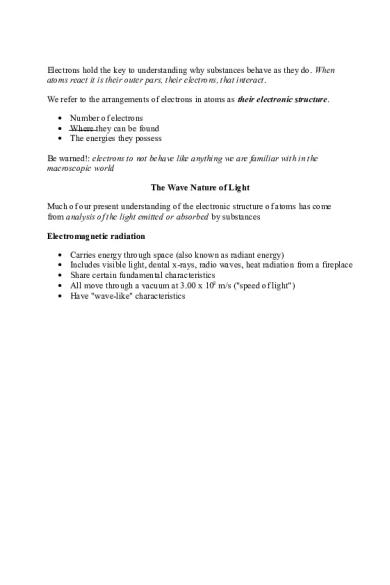Electronic Structure of Atoms PDF

| Title | Electronic Structure of Atoms |
|---|---|
| Course | General Chemistry |
| Institution | University of North Carolina at Charlotte |
| Pages | 34 |
| File Size | 1.4 MB |
| File Type | |
| Total Downloads | 54 |
| Total Views | 156 |
Summary
Notes on Electronic structure of atoms. Midterm material as well...
Description
Electrons hold the key to understanding why substances behave as they do. When atoms react it is their outer pars, their electrons, that interact. We refer to the arrangements of electrons in atoms as their electronic structure. Number of electrons Where they can be found The energies they possess Be warned!: electrons to not behave like anything we are familiar with in the macroscopic world The Wave Nature of Light Much of our present understanding of the electronic structure of atoms has come from analysis of the light emitted or absorbed by substances Electromagnetic radiation
Carries energy through space (also known as radiant energy) Includes visible light, dental x-rays, radio waves, heat radiation from a fireplace Share certain fundamental characteristics All move through a vacuum at 3.00 x 108 m/s ("speed of light") Have "wave-like" characteristics
The number of complete wavelengths, or cycles, that pass a given point in 1 second is the frequency of the wave (frequency=cycles/second) Electromagnetic radiation has both electric and magnetic properties. The wave-like property of electromagnetic radiation is due to the periodic oscillations of these components. We can assign a frequency and a wavelength to electromagnetic radiation Because all electromagnetic radiation moves at the same speed (speed of light) wavelength and frequency are related
If the wavelength is long, there will be fewer cycles passing a given point per second, thus the frequency will be low If the wavelength is short, there will be more cycles passing a given point per second, and the frequency will be high Thus, there is an inverse relationship between wavelength and frequency
(frequency [nu] * wavelength[lambda]) is a constant (c)
What is the speed of a wave? Imagine you are on the beach watching the ocean waves go by, and you want to know the speed of the waves. There is an island offshore with a palm tree that will serve as a convenient frame of reference. You count the number of waves that pass by the tree in one minute:
In this case, two peaks (two wavelengths) pass by the tree in one minute. Thus, the frequency is 2 wavelengths/minute. If we measure the distance between the peaks (i.e. the wavelength) we can determine the speed of the wave: Speed of the wave = (distance between peaks) * (frequency) = (wavelength) * (frequency)
The unit of length chosen to describe a particular wavelength is typically dependent on the type of electromagnetic radiation Unit
Symbol
Length (m)
Angstrom
Å
10-10
X-ray
Nanometer
nm
10-9
UV, vi
Micrometer
m
10-6
Infrare
Millimeter
mm
10-3
Infrare
Centimeter
cm
10-2
Microw
Meter
m
1
TV, ra
The range of EM wavelengths is dramatic The wavelengths of gamma-rays (...
Similar Free PDFs

Electronic Structure of Atoms
- 34 Pages

History OF Matter AND Atoms
- 2 Pages

Atom - worksheet about atoms
- 2 Pages

Citations Electronic
- 2 Pages

The structure of personality
- 6 Pages

Structure of English
- 16 Pages

Accessory Structure of Skin
- 2 Pages

Structure - summary of toefl
- 72 Pages

Electronic Business
- 164 Pages
Popular Institutions
- Tinajero National High School - Annex
- Politeknik Caltex Riau
- Yokohama City University
- SGT University
- University of Al-Qadisiyah
- Divine Word College of Vigan
- Techniek College Rotterdam
- Universidade de Santiago
- Universiti Teknologi MARA Cawangan Johor Kampus Pasir Gudang
- Poltekkes Kemenkes Yogyakarta
- Baguio City National High School
- Colegio san marcos
- preparatoria uno
- Centro de Bachillerato Tecnológico Industrial y de Servicios No. 107
- Dalian Maritime University
- Quang Trung Secondary School
- Colegio Tecnológico en Informática
- Corporación Regional de Educación Superior
- Grupo CEDVA
- Dar Al Uloom University
- Centro de Estudios Preuniversitarios de la Universidad Nacional de Ingeniería
- 上智大学
- Aakash International School, Nuna Majara
- San Felipe Neri Catholic School
- Kang Chiao International School - New Taipei City
- Misamis Occidental National High School
- Institución Educativa Escuela Normal Juan Ladrilleros
- Kolehiyo ng Pantukan
- Batanes State College
- Instituto Continental
- Sekolah Menengah Kejuruan Kesehatan Kaltara (Tarakan)
- Colegio de La Inmaculada Concepcion - Cebu






